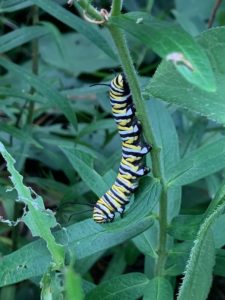
By Mary Reid Barrow
This beautiful monarch caterpillar was on my milkweed the other day. It was one of a couple of dozen or more caterpillars all over the plants and munching them down to almost nothing.
This was the first time that I have had monarch butterflies descend on me like the this. I was more than excited and had to take a video of the hungry caterpillars and I also brought a few inside to grow up in my old butterfly cage.
I’d like to think that a couple of those caterpillars in the video might also be the ones I just found hanging from the cage lid. One had completed this chrysalis, looking for all the world like a piece of delicate jade jewelry. And the other one was in its “J” position as it was getting ready to go into chrysalis.

And here is one more video of a monarch a few weeks ago as it dined and danced over my milkweed. LRNow’s communications coordinator Morgan Schmidtendorff took the video. I like to think the butterfly may have been a female laying the eggs that not long ago hatched into many of my caterpillars!
I also like to think that when these two youngsters and all the rest emerge from the chrysalises, they might be the monarchs of fall. They are the monarchs who are stronger and tougher and are ready to make their way south toward Mexico for the winter.
The area along the Chesapeake Bay and down the oceanfront is what might be called Virginia Beach’s monarch flyway. Like many migrating birds, some monarchs take off from up north and head south down the Eastern shore, flying across the Chesapeake Bay and down the oceanfront, on to Mexico!
Once I saw monarchs gathered in huge numbers on a tree close to the Eastern Shore tip where they were awaiting fair winds to cross the Bay!
And I have heard motorists say that as they drove across the Chesapeake Bay-Bridge Tunnel, they would see a line of monarchs fluttering along the bridge-tunnel route too. Monarchs know the route is the shortest distance between two points just as humans knew that when they built the bridge-tunnel
As the butterflies fly on, they often can be seen in little groups fluttering along Shore Drive, heading east toward. Atlantic Avenue where they can be seen heading south in September and October.
I used to think the monarchs of summer flitted around from flower to flower nectaring and laying eggs like little gadabouts and the monarchs of fall flew with a real purpose.
Now after watching monarch life play out in my garden, I can’t help but think, that from day one, the monarchs life is nothing if not purposeful.
Do you have a favorite tree or plant with a story to tell? What relationships have you observed between plants and critters? Who eats whom? Who has babies where? Send an email to maryreid@lrnow.org